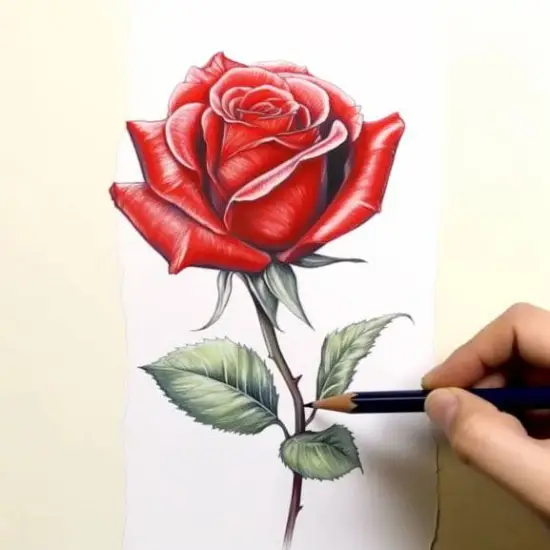Table of Contents
[Drawing:kkbuebxxlzy= Rose] Drawing a rose can seem challenging due to its intricate layers and delicate petals. However, with some guidance and practice, anyone can create a beautiful rose drawing. In this guide, we will break down the process step by step.
Materials You Will Need
Drawing:kkbuebxxlzy= Rose
Before starting, gather the following materials:
- Pencil (preferably with an eraser)
- Paper
- Fineliner or black ink pen (optional, for outlining)
- Colored pencils or watercolors (optional, for adding color)
Step 1: Draw the Center of the Rose

[Drawing:kkbuebxxlzy= Rose] Begin by drawing a small, tight spiral in the center of your page. This will represent the innermost part of the rose, where the petals start to curl tightly. Don’t worry about making it perfect—this will help create a natural, organic look.
Step 2: Add Inner Petals
[Drawing:kkbuebxxlzy= Rose] Around the spiral, start drawing small, curved shapes that mimic the appearance of petals. These petals should be slightly larger than the spiral and should overlap each other. These represent the innermost petals that are still tight and not yet fully opened.
Step 3: Draw the Outer Petals
[Drawing:kkbuebxxlzy= Rose] As you work outward, your petals should gradually become larger and more open. Keep drawing petals that curve around the center spiral, each one overlapping the previous petal. Vary the size and shape slightly to give the rose a more realistic appearance.
Step 4: Define the Shape of the Rose
[Drawing:kkbuebxxlzy= Rose] At this stage, you should have a basic shape of the rose formed by the petals. Use an eraser to refine any lines that look too harsh or that don’t contribute to the overall look. Make sure the petals look like they fold into one another naturally.
Step 5: Draw the Stem and Leaves

[Drawing:kkbuebxxlzy= Rose] Once you’re satisfied with the petals, draw a long, slightly curved line from the base of the rose for the stem. Add a few thorns along the stem, keeping them small and pointed. Then, draw two or three leaves attached to the stem. Rose leaves have an oval shape with serrated edges, so add that detail for realism.
Step 6: Add Shading and Texture

[Drawing:kkbuebxxlzy= Rose] Now that your rose outline is complete, you can start adding shading to give it depth. Focus on shading the areas where the petals overlap and curl inward. This will create contrast and make the rose appear more three-dimensional. Use gentle strokes to avoid harsh lines, and gradually build up the darker areas.
For the leaves, shade the center veins and the areas closer to the stem to make them look more lifelike.
Step 7: Outline and Add Color (Optional)
[Drawing:kkbuebxxlzy= Rose] If you want to give your rose more definition, use a fineliner or black ink pen to outline the entire drawing. This will make the drawing stand out and appear more polished. Afterward, you can use colored pencils or watercolors to add color to the petals and leaves.
For a classic look, color the petals red or pink and the leaves green. Experiment with blending different shades to create a gradient effect, adding more depth to your rose.
Conclusion
[Drawing:kkbuebxxlzy= Rose] Drawing a rose may seem daunting at first, but with patience and practice, it becomes easier. Remember, each rose is unique, so don’t worry about making every petal perfect. The beauty of nature lies in its imperfections. Follow this guide, and soon you’ll be able to draw beautiful roses with confidence!
Frequently Asked Questions (FAQs) About Drawing Roses
1. Do I need advanced drawing skills to draw a rose?
[Drawing:kkbuebxxlzy= Rose] No, you don’t need to be an advanced artist to draw a rose. This guide is designed for all skill levels, including beginners. Start with basic shapes and slowly work towards more intricate details as you gain confidence.
2. What type of pencil should I use for drawing a rose?
[Drawing:kkbuebxxlzy= Rose] A regular graphite pencil (HB) works well for drawing a rose. You may also use softer pencils (like 2B or 4B) for shading, as they create darker, smoother lines that are easier to blend. An eraser is also useful for refining your drawing.
3. How do I make the rose look more realistic?
[Drawing:kkbuebxxlzy= Rose] To make your rose drawing look more realistic, focus on the shading and the natural curves of the petals. Pay attention to how light would hit the petals and where shadows would fall. Soft, gradual shading helps create a sense of depth and realism.
4. How can I practice drawing roses?
Start by drawing simple roses using reference images or real flowers. Break down the rose into basic shapes and practice drawing the petals from different angles. Over time, as you practice, you’ll gain a better understanding of how to capture the rose’s complex structure.
5. Is it better to use colored pencils or watercolors to add color?
It depends on your personal preference. Colored pencils offer more control and allow for detailed coloring, while watercolors create a softer, more blended effect. You can experiment with both mediums to see which one suits your style better.
6. Can I draw roses in different styles, like abstract or cartoonish?
Absolutely! You can adapt this guide to create roses in any style you like—whether realistic, abstract, cartoonish, or something entirely unique. Experimenting with different styles is a great way to develop your artistic voice.
7. How do I avoid making the petals look flat?
To avoid flat-looking petals, focus on the natural folds and curves in each petal. Use shading to emphasize these curves, and ensure that each petal overlaps the others naturally. Varying the shapes and sizes of the petals will also help add dimension to your drawing.
8. What should I do if I make a mistake?
Mistakes are part of the process! Use an eraser to correct any lines that don’t look right, or incorporate the mistake into the drawing. Sometimes, an unexpected line can lead to a creative solution. The important thing is to stay patient and not get discouraged.
9. How long does it take to learn to draw a rose well?
The time it takes to learn to draw a rose depends on how often you practice and your prior experience with drawing. With consistent practice, you can start seeing improvement within a few days or weeks. The key is to keep drawing and experimenting.
10. Can I use a digital drawing tool instead of traditional materials?
Yes! Many artists use digital drawing tools like tablets and software such as Procreate, Photoshop, or Illustrator. The same principles apply—focus on building the structure of the rose and gradually add details, shading, and color. Digital tools also offer the advantage of layers and easy correction.
These FAQs should provide additional insight and tips to help you feel confident in your rose drawing journey.
Map:7m4tisnykes= new york Ultimate Travel Guide with Insider Tips and Must-See Attractions











